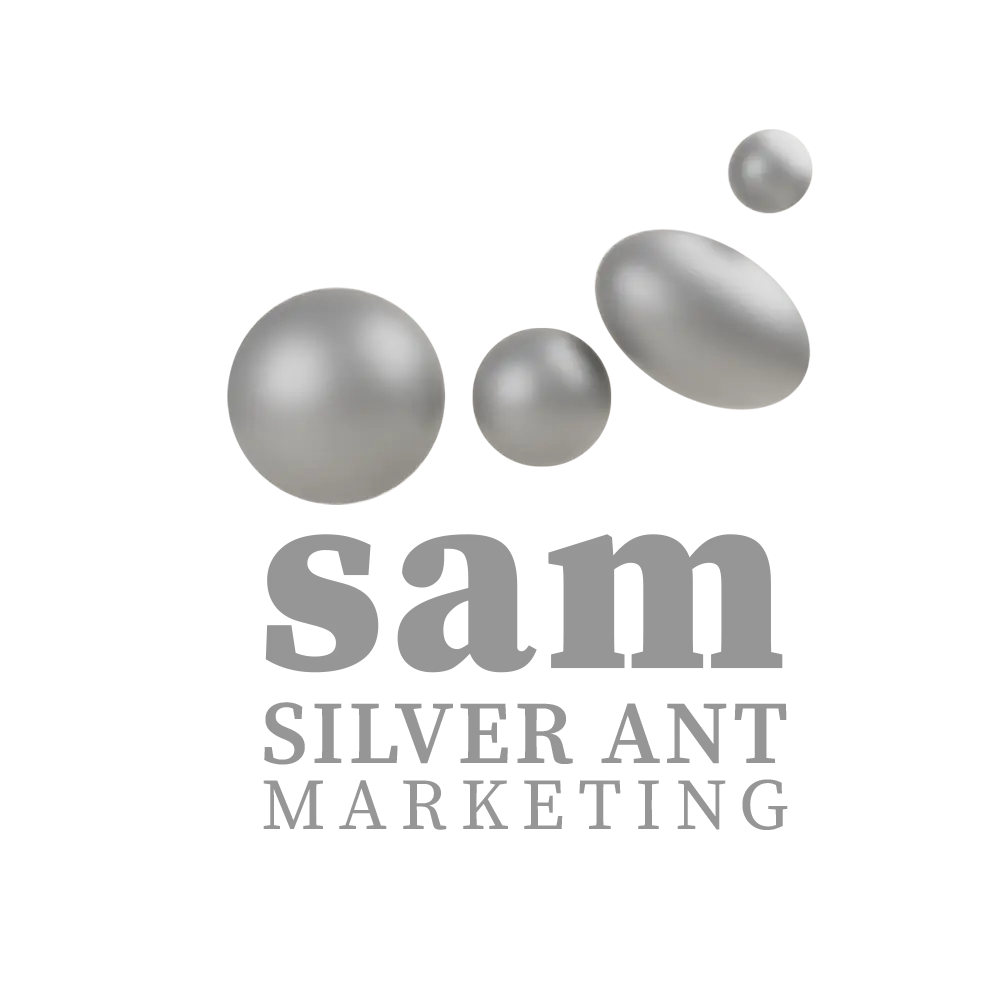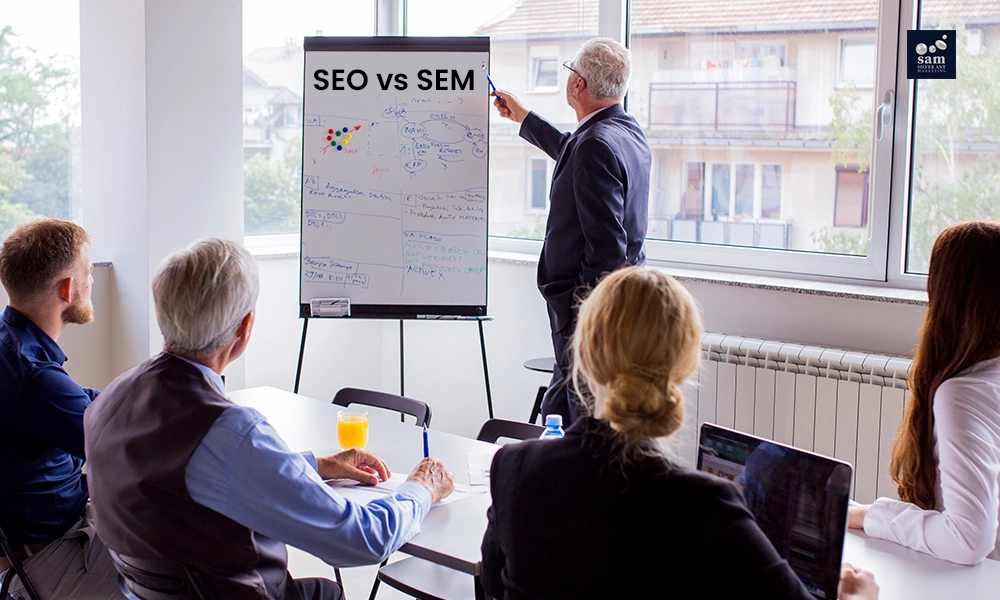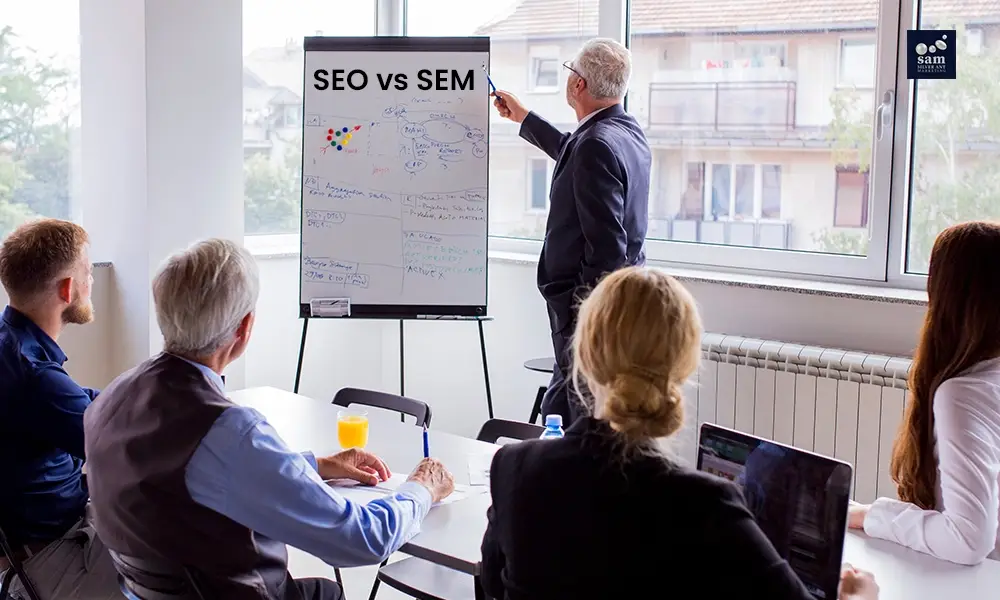Let’s begin by making a quick comparison between SEO vs SEM in digital marketing.
SEO vs. SEM: What’s the Difference?
When you Google something, you usually get two kinds of results:
Organic search results: A search engine results page (SERP) including unpaid listings. They show up because the user’s search query is related to them, according to the search engine’s algorithm.
Paid search results: Paid advertising that show up in the search engine results page. To set these results apart from organic results, they usually have an “Ad” or “Sponsored” tag. Paid search results are sometimes referred to as pay-per-click (PPC) or paid advertising since the businesses who use them are charged a fee each time the ad is clicked.
Here’s a visual comparison of SEM vs SEO in the SERP:
| Feature | SEO (Organic) | SEM (Paid) |
|---|---|---|
| Cost | Free (but requires time and effort) | Pay-per-click (PPC) or flat rate |
| Speed of Results | Slow, takes months to see results | Immediate, as soon as the campaign is live |
| Sustainability | Long-term, builds over time | Short-term, dependent on budget and ad performance |
| Click-Through Rate (CTR) | Higher CTR on organic results (8.5% higher) | Lower CTR, but more immediate visibility |
| Example | Google’s organic search result listings | Paid Google ads with “Sponsored” tags |
Note: Studies show that organic results have a 8.5% higher CTR than paid ads (Source: BrightEdge)
What Is SEO?
SEO is the process of optimizing your website for search engines. It typically involves creating and refining pages that respond to user search intent—searching for relevant information or products. For a more in-depth breakdown, check out our comprehensive guide on SEO strategies.
The top few organic search results are more likely to feature pages with the most beneficial and pertinent material.
SEO Techniques Breakdown:
-
✅ On-Page SEO: Focuses on optimizing content and structure.
Example Strategy: Use keywords like “Best SEO Techniques 2025” in headings and subheadings. -
✅ Off-Page SEO: All actions outside of your website that increase visibility and rankings, such as backlink building.
Example Strategy: Earn backlinks from credible sites within your niche. -
✅ Technical SEO: Ensures your website is optimized for both search engines and users, covering things like mobile-friendliness and HTTPS encryption.
Example Strategy: Improve mobile responsiveness and implement SSL certificates for secure browsing.
On-Page SEO
Optimizing the content of your webpage for search engines is known as on-page SEO. However, the true goal is to improve such pages’ usefulness for people as well as search engines. To enhance the on-page SEO of your website, utilize Semrush’s On-Page SEO Checker. Launch the application, type in your domain, then select “Get ideas.” To finish configuring, adhere to the instructions. If you want assistance with this, go to our comprehensive setup guide. After that, the program will audit your pages. When finished, a link to the report will appear. Examine the widget labeled “TOP pages to optimize.” Next to any page, click “# ideas.” After that, the “Optimization Ideas” tab for the chosen page will be displayed to you. To enhance the on-page SEO of your website, heed the advice.
Let’s now discuss some popular on-page SEO marketing strategies to guarantee that the content of your webpage is optimized from the outset:
- 🎯 Create High-Quality, Authoritative Content
- 🎯 Optimize for Relevant Keywords
- 🎯 Write Descriptive Meta Tags
- 🎯 Build a Network of Internal Links
- 🎯 Maintain Clear URLs
Off-Page SEO
All of the actions you do outside of your website to increase its exposure and search engine rankings are referred to as off-page SEO.
Here are a few typical off-page SEO strategies:
- 🎯 Build Quality Backlinks
- 🎯 Invest in Local SEO
- 🎯 Write Guest Blog Posts
- 🎯 Gain Brand Mentions
Technical SEO
Technical SEO guarantees that your website is enhanced for both search engines and users. Consider it the mechanical work. With Site Audit, you may look for technical SEO problems on your website.
To begin with, you must make a project for your domain. If you want assistance with the setting, go to our comprehensive setup guide.
- ✅ Ensure Your Site Is Mobile-Friendly
- ✅ Craft a Clear XML Sitemap
- ✅ Use HTTPS
- ✅ Optimize Your Core Web Vitals
- ✅ Manage Redirects and Address Errors
| SEO Element | Best Practices | Impact on SERPs |
|---|---|---|
| Mobile-Friendliness | Optimize for mobile | Higher ranking potential |
| Page Speed | Faster load times | Reduces bounce rate |
| Backlinks | Quality over quantity | Improves authority and rankings |
Fact: Websites that are mobile-friendly see 62% higher engagement from mobile users (Source: Google)
What Is SEM?
SEM includes both SEO and the paid advertisements (PPC) you see in search engine results. Unlike SEO, SEM provides quicker visibility but requires a budget for paid ads.
PPC Components:
- ✅ Keyword Research: Identify keywords that align with business goals.
- ✅ PPC Bidding: Set competitive bids to ensure your ads appear prominently.
- ✅ Audience Targeting: Target ads to specific demographics or interests.
- ✅ Ad Creation: Craft compelling headlines and CTAs.
| SEM Strategy | Key Focus | Expected Outcome |
|---|---|---|
| PPC Ad Creation | Write compelling, targeted ads | Higher visibility and traffic |
| Audience Targeting | Focus on specific customer segments | Improved ROI and lower cost-per-click |
| Bid Management | Optimize bids based on performance | Better ad placement |
Case Study:
Local Bakery in New York
Goal: Increase local awareness and online orders.
Strategy
Combined local SEO (Google My Business) with PPC targeting specific zip codes and baking enthusiasts.
Results
A 30% increase in traffic and a 20% boost in orders within the first month.
SEO vs SEM: Costs
SEO Costs
SEO costs typically involve investment in content, backlink outreach, and SEO tools. Here’s an estimated breakdown:
| Service | Estimated Monthly Cost |
|---|---|
| SEO Audit | $500 – $5,000 |
| Content Creation | $500 – $2,000 |
| Backlink Outreach | $300 – $1,000 |
SEM Costs
Costs vary depending on your PPC campaign’s scope and keyword competitiveness. For example, average CPC (cost per click) on Google Ads in competitive sectors like insurance can be as high as $50 per click.
| Service | Estimated Monthly Cost |
|---|---|
| PPC Campaign Management | $1,000 – $10,000 |
| Paid Search Advertising | $500 – $20,000 (depending on budget) |
SEO vs SEM: How Long to See Results?
SEO is a long-term strategy, with visible results often taking 3–6 months. In contrast, SEM can show results in 24–48 hours, but requires continuous optimization to maintain high performance.
SEO vs SEM FAQs
It depends on your goals. SEO is great for sustainable, long-term growth, while SEM provides immediate results.
Yes, combining both allows you to achieve quick visibility with SEM while building long-term rankings with SEO.
Start with a budget based on your business goals, and scale up once you understand what works.
FOMO: The Power of Search Engine Visibility!
Did you know that businesses that actively manage both SEO and SEM are 75% more likely to outperform competitors who don’t? Make sure you’re not missing out on these high-visibility opportunities!
Get Started with SEO & SEM Today!
Want to see your business reach new heights with SEO and SEM? At Silver Ant Marketing, we’re experts in creating tailored digital marketing strategies to fit your unique needs.
Contact us to learn more and get started with a free SEO audit!
Let’s now discuss some popular on-page SEO marketing strategies to guarantee that the content of your webpage is optimized from the outset:








